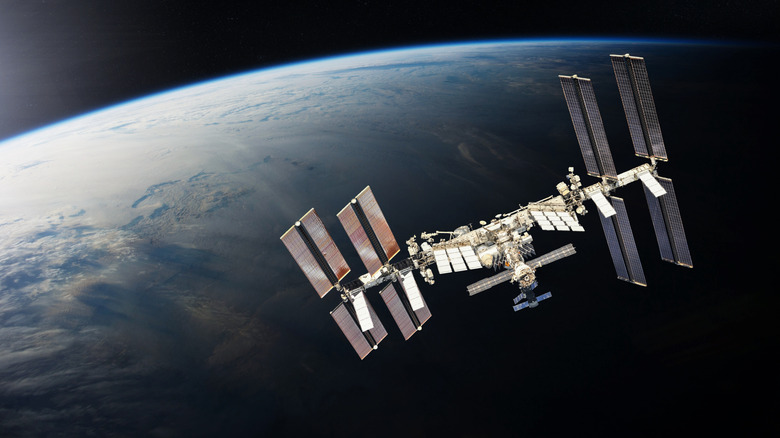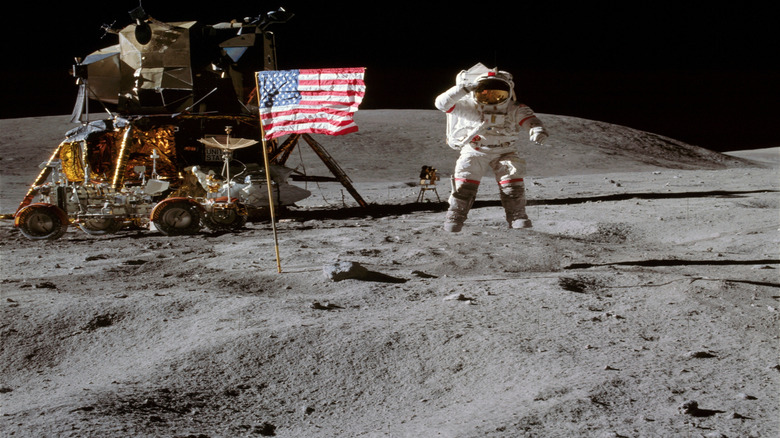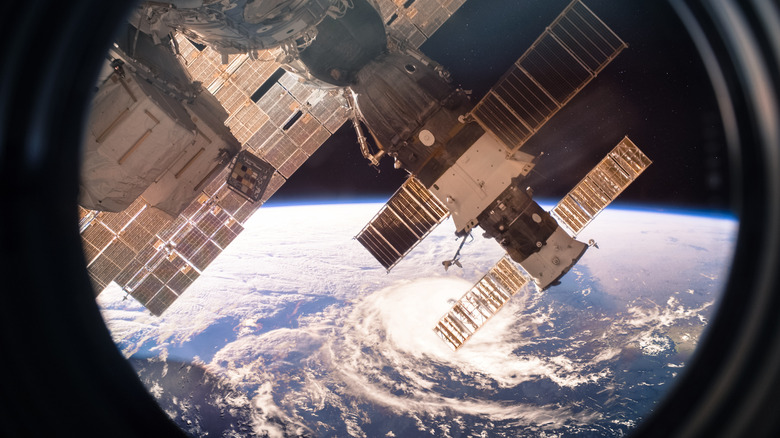The Hygiene Activity That's Banned On The International Space Station
If you're debating what the coolest job in the world is, it's sure difficult to argue against astronaut. As of the writing of this article, fewer than 700 people have journeyed beyond Earth, and in doing so, they've experienced things nobody else can really imagine. That includes downright awesome feats like floating in microgravity, but also some annoying hindrances. It's impossible to live a typical life aboard the International Space Station (ISS), where astronauts float in a state of perpetual freefall as their home in space spins around the planet. Many everyday activities are banned on the ISS. Some make obvious sense — you shouldn't get drunk around multi-billion dollar science equipment — but there's one side of life that you wouldn't think to be so restrained, and that's personal hygiene. Life on the ISS is so different from life on Earth, you can't even take a shower.
Water is not easy to handle without the help of gravity. On Earth, we turn on the showerhead, and good old gravity makes the water cascade down upon us. On the ISS, there is nothing to pull water down, so it just sticks where it lands. Attempting to use a normal shower would result in globs of water and soap clustering on your body rather than washing dirt and sweat off of it. Even worse, rogue droplets of water can get into the station's equipment, causing electrical shorts that could have disastrous consequences. To navigate this challenge, the ISS is equipped with a one-of-a-kind cleaning station.
A history of space showers
In the early days of NASA, during the Gemini and Apollo missions that ultimately led to the first man on the moon, hygiene was an afterthought. Astronauts had to make do with sponge baths, and they worked with a very limited water supply. Needless to say, when these astronauts returned to their home planet, they typically stunk to high heaven. When the Space Shuttle program launched in the 1980s, it too relied on a basic sponge bath system. Meanwhile though, humankind was building the first space stations, and taking astronaut hygiene to a new level.
On the space station Skylab, a predecessor to the ISS that launched in the 1970s, astronauts used a heavily modified version of a normal shower. The astronaut stood inside a tube with a shower head at the top and a drain at the bottom. The drain used a vacuum system to pull the water down and away, but the astronauts had to strap their feet to the shower floor to keep themselves in place. The process also took hours, as the astronauts had to dry themselves completely using a suction system that collected all of the water and soap to keep them away from electrical instruments.
How to get clean on the ISS
The hygiene facilities on the ISS are a significant improvement over the spaceflight missions that came before it, but they are even further from the shower routines we know on Earth. On the ISS, there is no free-flowing water, so the concept of rinsing your body is out of the question. Instead, astronauts use rinseless shampoo to clean their hair. Rinseless shampoo can be completely cleaned off with just a towel, and it is commonly used in hospitals to bathe patients who can't get out of bed. It's perfect for life aboard the space station because it eliminates the consequences of open water, aka floating water droplets all over everything.
For cleaning their bodies, astronauts use good old liquid soap and water, but with an unusual application method. The water is kept in small pouches with a tip to squeeze out just a tiny bit. Astronauts apply the water directly to their skin, using only a small amount so as to minimize cleanup. Instead of the aggressive old vacuum system, astronauts now dry off with the help of an airflow system that evaporates any droplet lingering on their skin.
Aside from the absence of gravity, water availability poses the greatest challenge to astronaut hygiene. The ISS is a marvel of water recycling technology. Every drop of moisture produced on board the station, from sweat to urine to the moisture from an astronaut's breath, gets sucked through a filter and purified for repeated use.


